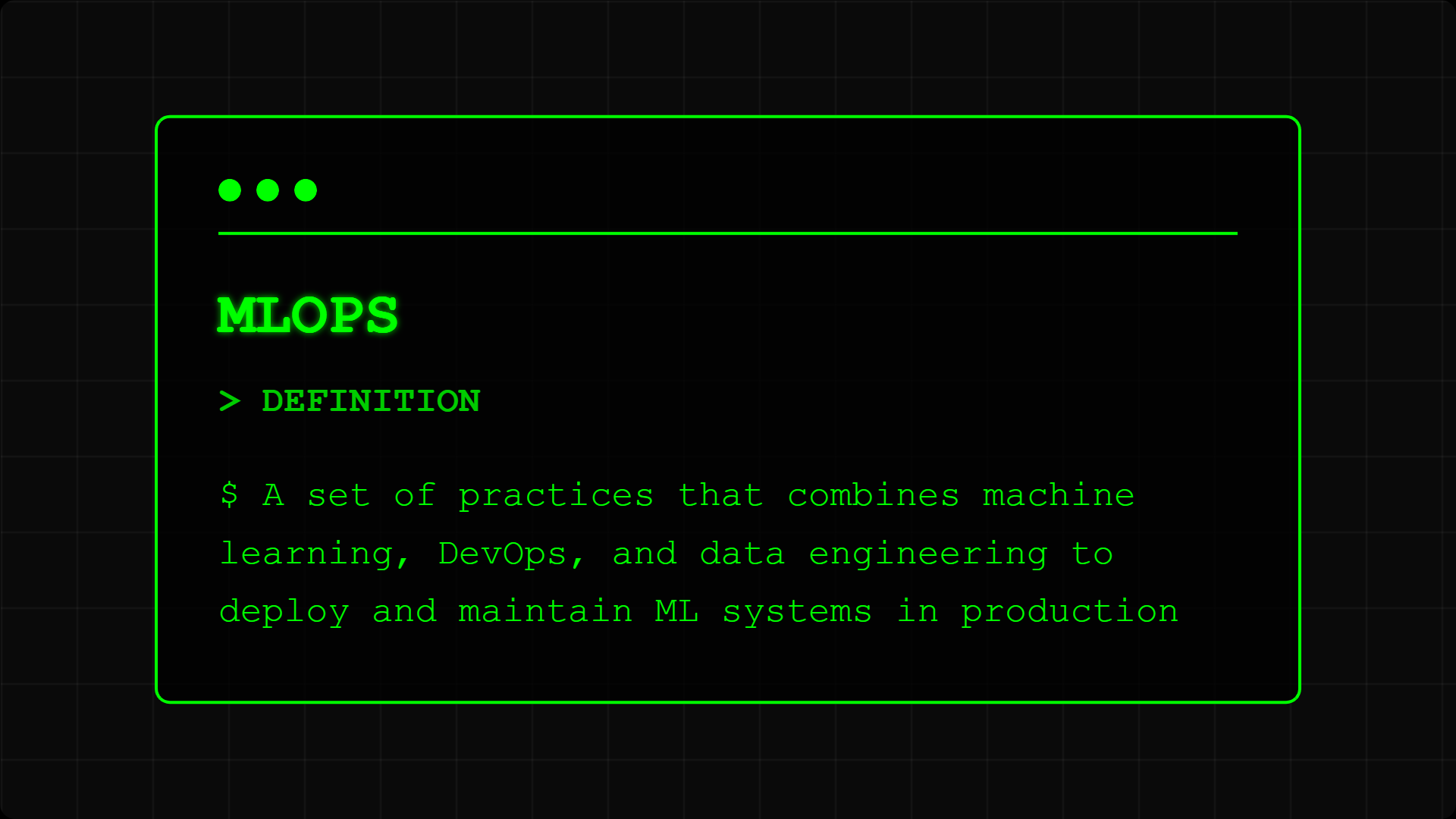AI Terms
What is MLOps? The Engineering Behind Reliable AI

Your data science team built an amazing AI model. Six months later, it's producing errors, running slowly, and no one knows why. This is where MLOps comes in – the discipline that keeps AI systems running reliably in the real world, not just in the lab.
Technical Definition
MLOps (Machine Learning Operations) is a set of practices that combines machine learning, DevOps, and data engineering to deploy and maintain ML models in production reliably and efficiently. It encompasses the entire ML lifecycle from data preparation through model training, deployment, monitoring, and retraining.
According to Google's engineering practices, MLOps is "the extension of DevOps methodology to include machine learning and data science assets as first-class citizens within the DevOps process." It emerged as organizations discovered that 87% of ML models never make it to production.
The framework addresses unique ML challenges like data drift, model decay, experiment tracking, and the need for continuous retraining that don't exist in traditional software.
Business Translation
For business leaders, MLOps is the difference between AI that works in PowerPoint presentations and AI that delivers value 24/7 in production – it's the operational excellence that turns AI experiments into business assets.
Think of MLOps like quality control for a manufacturing line, but for AI. Just as manufacturers need systems to ensure consistent product quality, MLOps ensures your AI models perform reliably, adapt to changes, and deliver consistent business value.
In practical terms, MLOps means your AI systems automatically detect when they need updates, retrain themselves on new data, and maintain audit trails for compliance – all while maintaining uptime and performance.
Core Components
MLOps encompasses these essential elements:
• Version Control: Tracking not just code but data, models, and experiments to ensure reproducibility and rollback capabilities
• Continuous Integration/Deployment (CI/CD): Automated pipelines that test, validate, and deploy models safely to production environments
• Model Monitoring: Real-time tracking of model performance, data quality, and business metrics to catch issues before they impact users
• Automated Retraining: Systems that detect model degradation and trigger retraining with fresh data to maintain accuracy
• Infrastructure Management: Scalable compute resources that handle varying workloads efficiently while controlling costs
The MLOps Lifecycle
MLOps processes follow this flow:
Development & Experimentation: Data scientists create models in controlled environments with experiment tracking and versioning
Validation & Testing: Automated testing ensures models meet performance, fairness, and business criteria before deployment
Deployment & Serving: Models deployed to production with proper scaling, failover, and integration with business systems
Monitoring & Maintenance: Continuous monitoring detects issues like data drift, triggering alerts or automated responses
Retraining & Updates: Regular or triggered retraining keeps models current with new data and changing conditions
MLOps Maturity Levels
Organizations progress through stages:
Level 0: Manual Process Characteristics: Scripts, manual deployment, no monitoring Risk: High failure rate, slow updates Example: Data scientist emails model files
Level 1: ML Pipeline Automation Characteristics: Automated training, manual deployment Risk: Deployment bottlenecks Example: Scheduled retraining, manual validation
Level 2: CI/CD Pipeline Characteristics: Automated testing and deployment Risk: Limited monitoring Example: Git push triggers model deployment
Level 3: Full MLOps Characteristics: Automated everything, self-healing systems Risk: Minimal Example: Netflix's recommendation system
Real-World MLOps
Companies achieving MLOps excellence:
Financial Services Example: Capital One's MLOps platform manages 7,000+ models in production, automatically retraining models when performance drops below thresholds, preventing millions in potential losses from model decay.
Retail Example: H&M's demand forecasting system uses MLOps to update predictions daily across 5,000 stores, automatically adjusting for seasonality, trends, and local events, reducing inventory costs by 20%.
Technology Example: Uber's Michelangelo platform serves 1 million predictions per second, with MLOps ensuring models adapt to changing traffic patterns, driver availability, and user behavior in real-time.
Key MLOps Practices
Essential practices for success:
Data Management:
- Version control for datasets
- Data quality monitoring
- Privacy compliance automation
Model Management:
- A/B testing frameworks
- Shadow mode deployment
- Gradual rollout strategies
Infrastructure:
- Auto-scaling for demand spikes
- Multi-region deployment
- Cost optimization
Governance:
- Audit trails for compliance
- Bias detection and mitigation
- Performance SLAs
Common MLOps Challenges
Typical obstacles and solutions:
• Data Drift: Models become less accurate as data patterns change → Solution: Automated drift detection and retraining triggers
• Technical Debt: Quick fixes accumulate → Solution: Regular refactoring and architectural reviews
• Team Silos: Data scientists vs. engineers → Solution: Cross-functional teams and shared responsibilities
• Tool Proliferation: Too many platforms → Solution: Standardized MLOps stack
Getting Started with MLOps
Ready to operationalize your AI?
- Start with Machine Learning fundamentals
- Understand AI Integration patterns
- Learn about Model Monitoring
- Read our MLOps Implementation Guide
FAQ Section
Frequently Asked Questions about MLOps
Part of the [AI Terms Collection]. Last updated: 2025-01-11